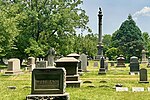Biles Creek (Delaware River tributary)
Rivers of Bucks County, PennsylvaniaRivers of PennsylvaniaTributaries of the Delaware River
Biles Creek is a tributary of the Delaware River in Falls Township, Bucks County, Pennsylvania. Named for William Biles, who purchased the island later known as Biles Island, consisting of 309 acres (125 ha). Biles arrived in Bucks County on 12 June 1679, three years before the arrival of William Penn.
Excerpt from the Wikipedia article Biles Creek (Delaware River tributary) (License: CC BY-SA 3.0, Authors).Biles Creek (Delaware River tributary)
Falls Township
Geographical coordinates (GPS) Address Nearby Places Show on map
Geographical coordinates (GPS)
| Latitude | Longitude |
|---|---|
| N 40.172777777778 ° | E -74.736944444444 ° |
Address
08611 Falls Township
Pennsylvania, United States
Open on Google Maps








